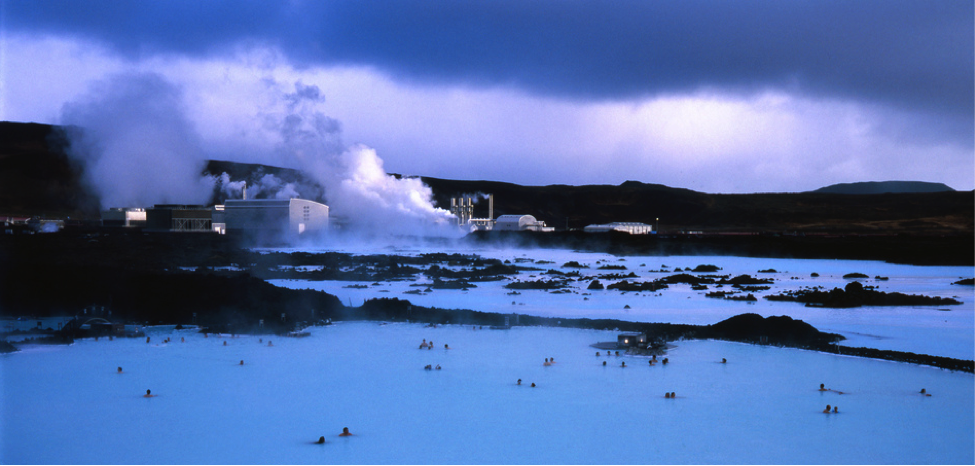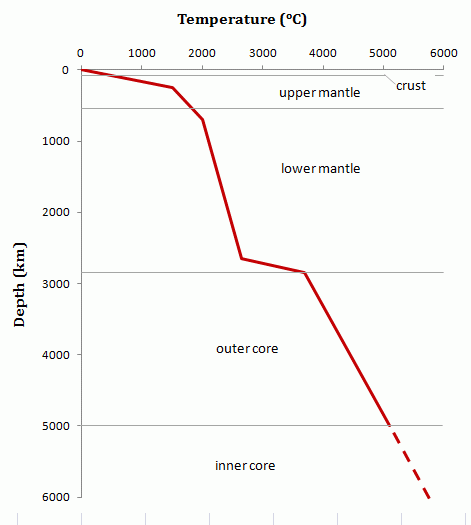8.4. Utility Scale Geothermal Energy Systems

There is a vast amount of heat contained by the earth interior. This internal heat is mainly comprised of the residual heat of planetary accretion and radioactive heat (from radioactive element decay). The hottest part of the earth is the core, a big part of which is in molten state. Heat radiates and gets transferred from the core to the outer layers of the planet by interior fluids and melts. The general geothermal profile of the earth (Figure 8.6) provides an idea of the scale of the thermal resource and the gradual change of the earth temperature at different depths. Because the earth structure is not uniform, heat is more readily transferred in some zones than in others. High heat transfer is usually associated with fracture zones and major faults, which are often located at the boundaries of tectonic plates.

The temperature change rate with depth depends on the density and thermal conductivity of rocks. Subdivision of the earth structure into layers is made according to the rock composition and rheological properties, so we see that the thermal profile within each layer can be quite different. The drastic change in temperature pattern around the boundary between the lower mantle and outer core is apparently related to the transition of the molten state.
The heat flux within the crust (the thin top layer) is highly variable due to the existence of large unified fragments of the crust (plates) divided by plate boundaries, the more mobile zones, where plates collide, spread out, or move relative to one another. Increased mobility of the plate boundary zones may cause creation of faults of various depth, which favor heat transfer to the surface. If you want more background about plate tectonic theory, you will be able to find a lot of resource on the web. For example, An Introduction to Plate Tectonics provides a nice and concise illustrated introduction to this whole idea.
There are a number of technologies that help convert the thermal flux and hydrothermal waters to usable energy. Next, we will refer to the following reading to learn how these technologies work.
Reading Assignment:
“How Geothermal Energy Works”, UCS, 4/1/2014
The following short video (5 min) provides an additional illustration of a utility scale geothermal plant.
Video: How a Geothermal Plant Works (4:45)
Welcome to one of CalEnergy's geothermal power plants. Unlike other power plants that rely on coal or other fossil fuels to create electricity for homes and businesses, geothermal power plants use superheated fluids from the Earth's geothermal resources to generate electricity. The natural heat of the Earth creates geothermal resources. This heat comes from molten rock called magma, located at the Earth's core deep below the geothermal resource. Over thousands of years, rainwater seeps through cracks in the Earth's surface and collects in underground reservoirs. The magma heats the water until it becomes a superheated fluid. To reach the superheated fluid, wells are drilled 5,000 to 10,000 feet below the surface of the Earth. These wells, called production wells, bring the superheated fluid to the Earth's surface where it can be used to generate electricity for homes and businesses.
This geothermal power plant uses crystallizer-reactor clarifier technology-- a process that turns the geothermal superheated fluid into steam, while removing solids from it. The steam is used to drive a turbine and generate electricity. All remaining geothermal fluids are injected back into the reservoir for reuse. Under its own pressure, superheated fluid from the geothermal resource flows naturally to the surface through production wells. As the liquid flows toward the surface, the pressure decreases, causing a small portion of the fluid still within the well to separate, or flash into steam. At the surface, the superheated fluid and steam mixture flows through surface pipelines and into a wellhead separator. Inside the separator, the pressure of the superheated fluid is reduced. This causes a large amount of the superheated fluid to rapidly vaporize and flash into high-pressure steam. The geothermal fluid that is not flashed into steam in the wellhead separator flows to a second vessel, called a standard-pressure crystallizer, where an additional amount of standard pressure steam is produced. The flash process continues in the low-pressure crystallizer. The remaining fluid is again flashed, this time at a lower pressure, to produce low-pressure steam. All of the low-pressure, standard-pressure, and high-pressure steam is delivered to a turbine. The fluid that is not flashed into steam flows into the reactor clarifier system and is then returned to the geothermal reservoir through injection wells. Turbines are the primary piece of equipment used to transform geothermal energy into mechanical energy. Pressurized steam created from the geothermal superheated fluid flows through pipelines to large steam turbines. The force and energy in the steam is used to spin the turbine blades. The turbines turn a shaft directly connected to an electrical generator. An electrical charge is created when magnets rotate within the generator. Large copper bars carry the electrical charge to a step-up transformer outside the plant. Within the transformer, the voltage is increased before the power is sent to the power lines that carry it to homes and businesses.
Geothermal energy is a sustainable resource because with proper management, a geothermal resource can remain a renewable source of energy. Water trapped deep within the Earth will naturally replace the superheated fluid that is drawn from the geothermal resource through surface wells. However, it is possible to deplete the geothermal resource by removing fluid faster than it can be naturally replaced. To help prevent this, the steam used in the geothermal power plant passes through a condenser that turns it back into fluid. At this stage, it's possible to recover minerals from the geothermal fluid before it's injected back into the Earth. This condensed fluid, along with a fluid that did not flash to steam, is injected back into the underground reservoir. Magma naturally reheats the fluid, so it can be used again.
While geothermal energy seems to be another unlimited and “free” energy resource, effective conversion of that energy and power distribution incur substantial costs. From economic evaluations, utility scale geothermal and natural gas power plants are comparable in overall cost, but only in the long term. Significant up-front expenditures for construction of the energy facility are much higher for the geothermal plant.
